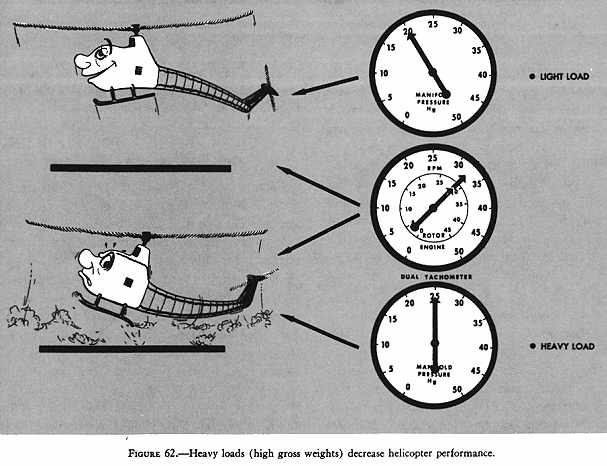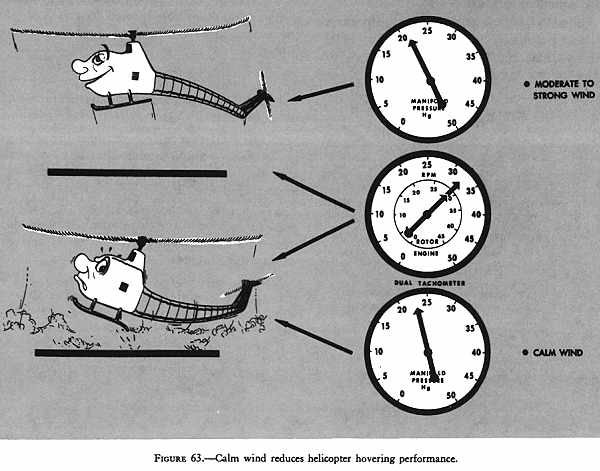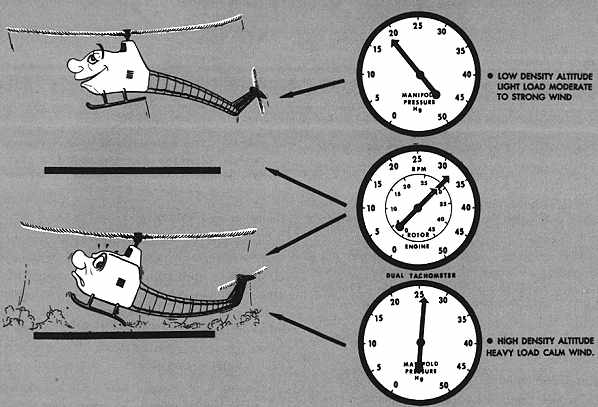
 |
||
| Home | Login | Schedule | Pilot Store | 7-Day IFR | IFR Adventure | Trip Reports | Blog | Fun | Reviews | Weather | Articles | Links | Helicopter | Download | Bio | ||
Site MapSubscribePrivate Pilot Learn to Fly Instrument Pilot 7 day IFR Rating IFR Adventure Commercial Pilot Multi-Engine Pilot Human Factors/CRM Recurrent Training Ground Schools Articles Privacy Policy About Me Keyword:  |
Chapter 8. HELICOPTER PERFORMANCE (CONTINUED) EFFECT OF GROSS WEIGHT ON HELICOPTER PERFORMANCE  We learned earlier that the total weight of a
helicopter is the first force that must be overcome before flight is
possible. Lift is the force that is needed to overcome or balance this
total weight. It is easily seen that the greater the gross weight of
the helicopter, the more lift that is required to hover. The amount of
lift available is dependent upon the angle of attack at which the rotor
blades can operate and still maintain required rotor RPM. The angle of
attack at which the blades can operate at required rotor RPM is
dependent upon the amount of power available. Therefore, the heavier
the gross weight, the greater the power required to hover and for
flight in general, and the poorer the performance of the helicopter
since less reserve power is available (fig. 62); or, to state it
another way, the heavier the gross weight, the lower the hovering
ceiling. We learned earlier that the total weight of a
helicopter is the first force that must be overcome before flight is
possible. Lift is the force that is needed to overcome or balance this
total weight. It is easily seen that the greater the gross weight of
the helicopter, the more lift that is required to hover. The amount of
lift available is dependent upon the angle of attack at which the rotor
blades can operate and still maintain required rotor RPM. The angle of
attack at which the blades can operate at required rotor RPM is
dependent upon the amount of power available. Therefore, the heavier
the gross weight, the greater the power required to hover and for
flight in general, and the poorer the performance of the helicopter
since less reserve power is available (fig. 62); or, to state it
another way, the heavier the gross weight, the lower the hovering
ceiling. A study of the hovering ceiling chart (fig. 56) reveals the following interesting information for one helicopter, and this is fairly typical for all helicopters (with unsupercharged engines). At 60° F. in dry air, the hovering ceilings for gross weights of 1,300, 1,400, 1,500, and 1,600 pounds are 9,400 feet, 7,400 feet, 5,900 feet, and 4,300 feet, respectively. An increase of 300 pounds in gross weight decreases the hovering ceiling by more than half. At gross weights of 1,300, 1,400, 1,500, and 1,600 pounds at a temperature of 100° F. in air with a relative humidity of 80 percent the hovering ceilings are 6,100 feet, 4,400 feet, 2,900 feet, and 1,300 feet, respectively. In the latter case, an increase of 300 pounds in gross weight reduces the hovering ceiling by almost 80 percent. A comparison of the two examples illustrates vividly the reduction in performance brought about by a combination of heavy gross weight and high density altitudes. Of the three major factors affecting the performance of a helicopter at high elevations (density altitude, wind, and gross weight), the pilot can control only the gross weight. It should be obvious that the gross weight carried on any flight must be considered - not only for takeoff under the existing density altitude, wind conditions, and power available at point of departure, but also under the expected density altitude, wind conditions, and power available at the landing destination. Smaller amounts of fuel may be carried to improve performance or to increase useful load. It must be remembered, however, that this necessitates a sacrifice in range. The importance of loading a helicopter within the approved center-of-gravity limits, and the ill effects on performance if this is not properly accomplished, have been discussed in the preceding chapter. EFFECT OF WIND ON HELICOPTER PERFORMANCE  We
have seen earlier that when the horizontal airspeed of the helicopter
reaches approximately 15 miles per hour, an abrupt increase in lift is
experienced. This we call effective translational lift. Actually, from
the moment the helicopter begins forward flight, translational lift is
present, but is not very apparent or effective under about 15 miles per
hour. We
have seen earlier that when the horizontal airspeed of the helicopter
reaches approximately 15 miles per hour, an abrupt increase in lift is
experienced. This we call effective translational lift. Actually, from
the moment the helicopter begins forward flight, translational lift is
present, but is not very apparent or effective under about 15 miles per
hour. Translational lift is created by airspeed, not groundspeed. Therefore, translational lift is also present when the helicopter is hovering in a wind. If the wind velocity is 15 miles per hour or more, the helicopter will be experiencing effective translational lift in a hover. Due to this increased lift, less power will be required to hover than would be required for hovering in a no-wind condition (see figure 63 to the right); or, a greater gross weight could be carried when takeoff is to be made in a wind exceeding 15 miles per hour than could be carried if takeoff is to be made in a no-wind condition. No-wind conditions increase the amount of power necessary to hover, or require that a lighter load be carried. Thus, no-wind conditions reduce helicopter performance. Since wind decreases the power required for hovering, or permits taking off or landing with greater loads, helicopter performance is improved. If the wind exceeds 15 miles per hour, performance is improved considerably; however, wind gusts over 30 to 35 miles per hour may tend to destroy the additional lift obtained between 15 and 30 miles per hour. PRACTICAL METHODS FOR PREDICTING HELICOPTER PERFORMANCE Certain practical methods for predicting helicopter performance were developed through engineering and flight tests for a particular model helicopter used by the Army. These practical methods for this particular helicopter are given in this handbook to give the reader a clearer understanding of factors influencing helicopter performance, and sound principles on which to base flight decisions. We wish to emphasize the fact that these rules are for a particular helicopter used by the Army and the actual figures will apply only to this particular helicopter. Even though such practical aids are developed for a helicopter, they should not be used as substitutes for experience and good judgment. Manifold pressure and payload Tests on this particular helicopter showed that 1 inch of manifold pressure was equivalent to 6 horsepower (HP), and that 1 HP would lift 13.5 pounds of weight while hovering. When combined, these two facts give rise to this practical rule: Rule No. 1 - One inch of manifold pressure will lift 80 pounds of payload. With this knowledge, the pilot can obtain an estimate of the additional weight that can safely be carried to hover and then to enter flight. This rule may be applied before landing at destination in this manner:
Manifold pressure and hovering ceiling By using available manifold pressure to determine hovering ceiling, a pilot can predict whether or not hovering flight is possible at the destination. Rule No. 2 - If wind velocity at point of intended landing is approximately the same as at point of takeoff, and the flight is made within the same air mass (no radical temperature change), for each inch of manifold pressure in excess of that required to hover, add 1,000 feet to the point-of-takeoff altitude. This computed altitude will represent the approximate hovering ceiling. This practical rule may be applied as follows:
In winds from 0 to 15 miles per hour, the hovering ceiling of the helicopter will increase about 100 feet for each mile per hour of wind. In winds from about 15 MPH to 26 MPH, the hovering ceiling will increase about 350 feet for each mile per hour of wind. Rule No. 3 - The payload may be increased 8 pounds for each mile per hour of wind from 0 to 15 miles per hour, or may be increased 28 pounds for each mile per hour of wind from 15 MPH to 26 MPH. Hovering and skid height The hovering altitude over level terrain for this particular helicopter is ideal with a skid clearance of approximately 4 feet (height of skid above the ground). Variable hovering altitudes, due to obstacles or rough terrain, have a decided effect on helicopter performance in determining hovering ceiling and payload. These effects are best estimated as follows: Rule No. 4 - (1) To hover under 4 feet, add 300 feet to the hovering ceiling or 24 pounds to the payload for each 6 inches of decrease in skid height from the 4-foot hover. (2) To hover between 4 feet and 10 feet, subtract 300 feet from the hovering ceiling or 24 pounds from the payload for each foot of increase in skid height. Hovering ceiling and gross weight The hovering ceiling will vary in proportion to the gross weight of the helicopter. To determine hovering ceiling for a known gross weight, apply the following rule: Rule No. 5 - (1) A 100-pound REDUCTION in gross weight increases hovering ceiling in or out of ground effect about 1,300 feet. (2) A 100-pound INCREASE in gross weight decreases hovering ceiling about 1,300 feet. Service ceiling and gross weight The service ceiling of the helicopter varies with gross weight. (For all practical purposes, service ceiling is the maximum obtainable altitude.) To determine the effects of gross weight on service ceiling, apply the following rule: Rule No. 6 - A 100-pound DECREASE In gross weight adds 800 feet to the service ceiling, and, conversely, a 100-pound INCREASE in gross weight reduces the service ceiling 800 feet. We wish to reemphasize that these rules are for one particular helicopter used by the Army and the actual figures will apply only to this helicopter. BRIEF SUMMARY  A thumbnail summary of this chapter might be
as follows: A thumbnail summary of this chapter might be
as follows:
Your Thoughts... |

|
| Home | Login | Schedule | Pilot Store | 7-Day IFR | IFR Adventure | Trip Reports | Blog | Fun | Reviews | Weather | Articles | Links | Helicopter | Download | Bio |
| All content is Copyright 2002-2010 by Darren Smith. All rights reserved. Subject to change without notice. This website is not a substitute for competent flight instruction. There are no representations or warranties of any kind made pertaining to this service/information and any warranty, express or implied, is excluded and disclaimed including but not limited to the implied warranties of merchantability and/or fitness for a particular purpose. Under no circumstances or theories of liability, including without limitation the negligence of any party, contract, warranty or strict liability in tort, shall the website creator/author or any of its affiliated or related organizations be liable for any direct, indirect, incidental, special, consequential or punitive damages as a result of the use of, or the inability to use, any information provided through this service even if advised of the possibility of such damages. For more information about this website, including the privacy policy, see about this website. |